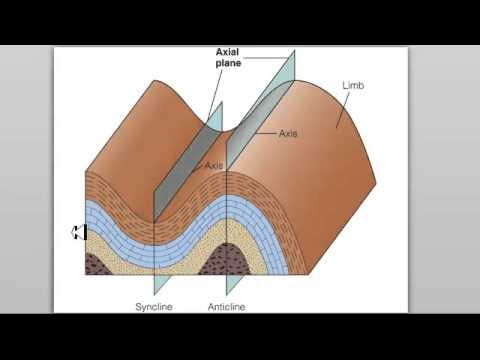TYPES OF ROCK STRESS
Summary
TLDRThis script explains the three types of stress that affect rocks and can lead to earthquakes: tension, compression, and shearing. Tension occurs at divergent boundaries, causing the rock to thin like a stretched rubber band, exemplified by the Great Rift Valley of Africa. Compression happens at convergent boundaries, where plates meet and cause folding or breaking, as seen in the Rocky Mountains. Shearing takes place at transform boundaries, where plates slide past each other, leading to faults like the San Andreas. These stresses also shape plate boundaries, with tensional stress at divergent boundaries creating features like oceanic spreading ridges, compressive stress forming mountain ranges at convergent boundaries, and shear stress at transform boundaries causing horizontal plate movement.
Takeaways
- 🌏 Stress is a force that can change the shape or volume of rocks and is a key factor in causing earthquakes.
- 🔗 There are three types of stress: tension, compression, and shearing, each associated with different geological phenomena.
- 📢 Tension occurs at divergent boundaries where plates are pulled apart, causing the crust to thin, similar to stretching a rubber band.
- 🏞️ The Great Rift Valley of Africa is an example of a geological feature created by tensional stress.
- 🏔️ Compression happens at convergent boundaries where plates come together, causing the crust to fold or break, such as in the formation of the Rocky Mountains.
- ⛓️ Shearing takes place at transform boundaries where plates slide past each other, leading to the formation of faults like the San Andreas Fault.
- 📉 Normal faults are formed when tensional stress causes the hanging wall to drop relative to the foot wall.
- 📈 Reverse faults are created by compressive stress, which shortens the rock and causes the opposite motion to normal faults.
- 🔄 Strike-slip faults are the result of shearing stress, where rock is pushed horizontally in opposite directions, causing little to no vertical movement.
- 🌍 Tensional stress at divergent plate boundaries can lead to the formation of oceanic spreading ridges and long mountain ranges.
- 🏞️ Compressive stress at convergent plate boundaries results in broad uplifts like the Himalayas or coastal mountain ranges formed by subduction.
- 🔄 Shear stress at transform boundaries is characterized by horizontal sliding of plates, often seen in the ocean basins and along faults like the San Andreas.
Q & A
What is stress in the context of geology?
-In geology, stress refers to a force that acts on rock, causing it to change shape or volume. It can lead to geological events such as earthquakes.
What are the three types of stress that affect rocks?
-The three types of stress are tension, compression, and shearing.
At what type of tectonic plate boundary does tension occur?
-Tension occurs at divergent boundaries where tectonic plates are being pulled apart.
How does tension affect the Earth's crust?
-Tension pulls on the crust, causing it to thin, similar to a rubber band being stretched.
What is an example of a geographical feature formed by tension?
-The Great Rift Valley of Africa is an example of a feature created by tension.
What happens at convergent boundaries in terms of stress?
-At convergent boundaries, compression occurs as plates come together, causing the crust to fold or break.
How does compression lead to the formation of mountains?
-Compression can cause the crust to buckle, leading to the formation of mountain ranges like the Rocky Mountains.
What is shearing and where does it typically occur?
-Shearing is a type of stress that occurs at transform boundaries where plates slip past each other, causing the rock to break or slip apart.
How does the San Andreas Fault relate to shearing stress?
-The San Andreas Fault is an example of a transform boundary created by shearing stress, where the Pacific and North American plates slide past each other.
What are the three broad classes of faults based on stress direction?
-The three classes of faults are normal faults, reverse faults, and strike-slip faults, which correspond to tensional, compressive, and shearing stresses, respectively.
How do stress regimes influence the formation of plate boundaries?
-Stress regimes act both locally on faults and at a larger regional scale to create the three basic types of plate boundaries: divergent, convergent, and transform.
What happens when tensional stress is applied to rocks?
-When tensional stress is applied, rocks extend and initially form fractures at an angle of less than 70 degrees to the surface, leading to normal faults.
What is the result of compressive stress on rocks?
-Compressive stress causes rocks to shorten, resulting in reverse faults where the hanging wall moves up relative to the foot wall.
How does shear stress manifest at transform boundaries?
-Shear stress at transform boundaries results in strike-slip faults, where there is horizontal movement with little to no vertical motion.
Outlines

Dieser Bereich ist nur für Premium-Benutzer verfügbar. Bitte führen Sie ein Upgrade durch, um auf diesen Abschnitt zuzugreifen.
Upgrade durchführenMindmap

Dieser Bereich ist nur für Premium-Benutzer verfügbar. Bitte führen Sie ein Upgrade durch, um auf diesen Abschnitt zuzugreifen.
Upgrade durchführenKeywords

Dieser Bereich ist nur für Premium-Benutzer verfügbar. Bitte führen Sie ein Upgrade durch, um auf diesen Abschnitt zuzugreifen.
Upgrade durchführenHighlights

Dieser Bereich ist nur für Premium-Benutzer verfügbar. Bitte führen Sie ein Upgrade durch, um auf diesen Abschnitt zuzugreifen.
Upgrade durchführenTranscripts

Dieser Bereich ist nur für Premium-Benutzer verfügbar. Bitte führen Sie ein Upgrade durch, um auf diesen Abschnitt zuzugreifen.
Upgrade durchführen5.0 / 5 (0 votes)






